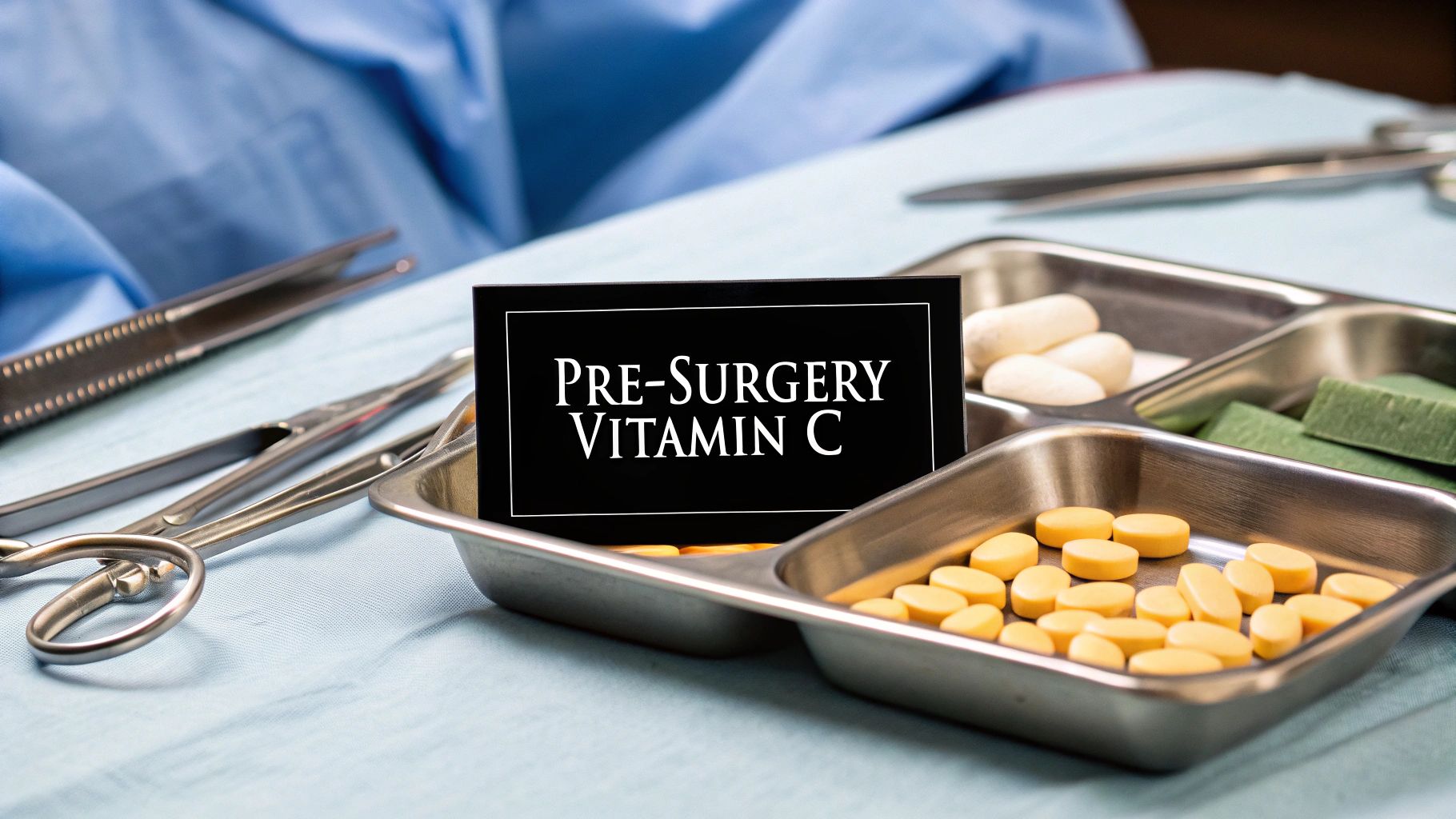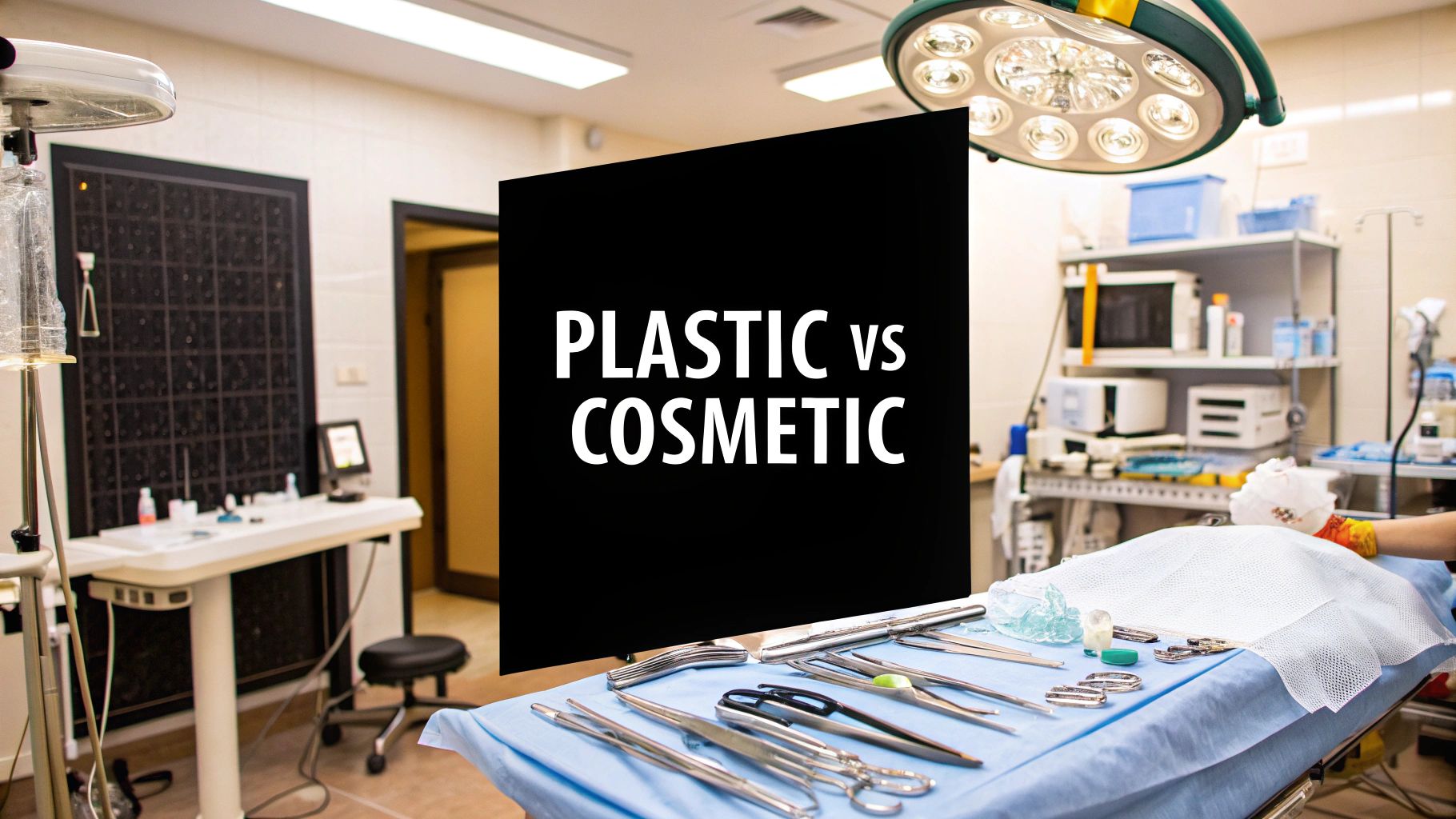
November 22, 2025
Taking Vitamin C Before Surgery An Expert Guide
Considering vitamin C before surgery? This guide covers the science-backed benefits for healing, potential risks, and crucial advice from surgeons.
Oct 7, 2025

You've probably heard the terms "plastic surgery" and "cosmetic surgery" used as if they mean the same thing. While they're closely related and often overlap, their core philosophies and the reasons patients seek them out are fundamentally different.
The simplest way to think about it is this: plastic surgery is about reconstructing defects to restore normal function and appearance. On the other hand, cosmetic surgery is all about enhancing aesthetic appearance.
At its heart, plastic surgery is a broad, reconstructive field. It's designed to correct abnormalities caused by birth defects, injuries, burns, or diseases. The goal isn't just to make something look better, but to restore a person's body to a normal state of form and function. Think of procedures like breast reconstruction after a mastectomy or repairing a cleft lip.
To learn more about the full scope of this specialty, you can explore our detailed guide on what is plastic surgery.
Cosmetic surgery, by contrast, is entirely elective. It focuses on improving the aesthetic appeal of normal body structures. Patients who choose cosmetic procedures—like a facelift or liposuction—are looking to enhance their appearance based on personal desires, not medical necessity. This distinction is more than just a technicality; it shapes everything from your choice of surgeon to whether your insurance will cover the procedure.
Here’s a quick summary to see the differences side-by-side.
This table breaks down the fundamental differences between the two fields, covering their primary goals, typical patient motivations, and common procedure examples.
Understanding these distinctions helps you clarify your own goals and find the right specialist for your needs.
Demand for both types of procedures is skyrocketing. In a single recent year, surgeons performed an estimated 38 million aesthetic procedures around the world. That's a staggering 42.5% increase in just four years, showing a clear and growing interest in aesthetic improvements.
When you're trying to decide between plastic surgery and cosmetic surgery, one of the most important things to look at is the surgeon's background. The training and certification paths are completely different, and this difference has a huge impact on their expertise, qualifications, and ultimately, your safety and results.
A board-certified plastic surgeon has gone through an incredibly rigorous, standardized training process. After finishing medical school, they have to complete a demanding residency, often in general surgery, before even starting a specialized plastic surgery residency. That second residency can last three years or more and covers everything from complex reconstructive surgeries to the fine details of aesthetic work.

Now, here's where it gets tricky. The term "cosmetic surgeon" isn't regulated in the same way. A doctor from just about any specialty—dermatology, general practice, you name it—can legally perform cosmetic procedures after attending some weekend courses or workshops.
While many are competent, they simply don't have the deep, foundational training in reconstructive principles that is the hallmark of a plastic surgeon. This is precisely why doing your homework on credentials is non-negotiable.
In the United States, the gold standard is certification from the American Board of Plastic Surgery (ABPS). This is your guarantee that a surgeon has not only finished an accredited plastic surgery residency but has also passed intensive written and oral exams on both reconstructive and cosmetic surgery.
So, what does that ABPS certification really mean for you? It means your surgeon has a profound understanding of human anatomy, surgical artistry, and patient safety protocols needed for a huge variety of complex situations.
This extensive background equips them to manage potential complications effectively and deliver reliable, high-quality outcomes. It's also worth digging into the difference between a surgeon who is board-eligible versus one who is fully board-certified. To get a better handle on this, you can explore the key distinctions between a board-eligible vs board-certified surgeon. At the end of the day, that certification provides a critical layer of confidence when you're considering surgery.
At the heart of the plastic vs. cosmetic surgery debate is a fundamental difference in philosophy. It's this core principle that shapes everything, from the very first conversation with a patient to what everyone agrees is a "successful" result. The two specialties are simply aiming for different things.

Plastic surgery is all about reconstruction. Its primary mission is to repair defects and bring the body back to a normal state, both in how it works and how it looks. We're talking about fixing problems that stem from trauma, disease, or birth disorders.
The entire focus of plastic surgery is restorative. Success here is measured by how well a procedure rebuilds a patient's anatomy, improves their physical abilities, and helps them live a normal life again.
Cosmetic surgery, on the other hand, is exclusively focused on aesthetic enhancement. The goal is to improve the appearance of otherwise normal body structures to help a patient match their personal idea of beauty. In this world, success is judged almost entirely by how happy the patient is with the way they look.
This split in purpose isn't new; it has deep historical roots. Plastic surgery really came into its own after World War I, born from the urgent need to treat soldiers with devastating injuries. The entire field was built around restoring function and a sense of normalcy.
Cosmetic surgery, in contrast, saw its popularity surge after the 1960s, as society became more open to the idea of elective procedures. To get a better sense of this journey, you can dig into the historical development of these surgical fields.
Think of it this way: a burn victim needing skin grafts to move their arm again is a clear-cut plastic surgery case. Success means they can use their arm. Someone wanting a facelift to look less tired is a classic cosmetic surgery patient, where success is all about achieving that refreshed, more youthful appearance. This simple difference in why the surgery is being done is what truly sets the two fields apart.
The easiest way to grasp the difference between plastic and cosmetic surgery is to look at the procedures themselves. It’s not just about what the surgeon does, but why they’re doing it. The motivation behind the surgery is the real key.
Plastic surgery is all about reconstruction—restoring form and function. Think of breast reconstruction after a mastectomy. The goal isn't just aesthetic; it's about helping a patient feel whole again after battling cancer.
Other classic examples of reconstructive plastic surgery include:
Cosmetic surgery, on the other hand, is driven entirely by aesthetics. These are procedures performed to enhance or reshape parts of the body that are already functioning normally. For example, liposuction contours areas by removing pockets of fat, and a facelift is designed specifically to reduce the visible signs of aging.
Now, here's where it can get a little fuzzy. Some procedures walk the line between both fields. Rhinoplasty, or a "nose job," is a perfect example. It can be purely cosmetic—someone simply wants to change the shape of their nose. But it can also be a reconstructive procedure to fix a deviated septum that’s making it hard for them to breathe. It all comes down to the patient's primary goal.
To help clarify this, let's look at where common procedures typically fall.
As you can see, the "why" behind the surgery is what really matters. A procedure like eyelid surgery can be done to create a more youthful look (cosmetic) or to remove drooping skin that's impairing a person's vision (reconstructive).
The chart below offers a visual snapshot of what patients might expect in terms of outcomes for both categories.

While patient satisfaction is high across the board, the data highlights that reconstructive surgery often comes with a longer, more involved recovery, which makes sense given its complexity.
It's also interesting to see how trends in cosmetic procedures shift over time. For instance, eyelid surgery has surged in popularity, with over 2.1 million procedures performed—a jump of 13.4%. In contrast, breast augmentations, while still very common with 3.9 million cases, actually saw a 14.1% decrease, pointing to changing beauty standards. You can dive deeper into these trends by exploring the latest global surgery statistics.
Let’s talk about one of the biggest factors for most people: the money. When it comes to paying for surgery, the line between plastic and cosmetic procedures couldn't be clearer, and it all comes down to one thing: medical necessity.
If a procedure is meant to restore your body's function or correct a deformity, insurance will often step in to help cover the cost. Think of plastic surgery in its reconstructive role—like rebuilding a breast after a mastectomy or correcting a cleft palate. These aren't just about appearance; they're about restoring wholeness.
Getting that coverage isn't automatic, though. You and your surgeon's office will need to get pre-authorization from your insurance company. This usually means submitting a ton of paperwork to prove the surgery is truly necessary for your health and well-being.
Now, flip the coin to cosmetic surgery. Because these procedures are chosen purely to enhance your appearance, they're considered elective. That means you'll almost always be paying for them yourself, out-of-pocket.
Insurers just don't cover procedures that aren’t medically required. This includes things like facelifts, liposuction, and breast augmentation for aesthetic reasons. To get a better feel for what’s involved, you can look into the costs associated with cosmetic procedures like Scalp Micropigmentation.
The fundamental rule is simple if the primary goal is reconstructive, insurance may help. If the goal is purely aesthetic, the financial responsibility falls to the patient.
Because of this clear divide, most cosmetic surgeons offer financing plans to make the procedures more manageable. These let you pay for your surgery over time, which can make your goals feel much more attainable. It’s a great idea to bring this up during your consultation so you can map out a financial plan that works for you. Getting a handle on the costs is a huge part of your decision-making process.

Finding the right surgeon is hands-down the most important decision you'll make. It all starts with being honest about your goals. Are you looking to repair damage from an accident or illness and get back to normal? Or is your aim purely aesthetic, to enhance a feature you'd like to change?
If your needs are reconstructive, a board-certified plastic surgeon is non-negotiable. Their training is incredibly rigorous and covers the intricate techniques required to restore both form and function. When your goal is cosmetic, you might find surgeons who focus only on aesthetics. Even so, board certification in plastic surgery remains the gold standard because it signals a deeper, more comprehensive understanding of the entire human anatomy.
Once you've narrowed down your options, the consultation is your time to get answers and gauge your comfort level. Don't be shy; this is your health and your body. Come prepared with a list of questions to make sure the surgeon’s experience matches your specific needs.
Here are a few must-ask questions:
A great surgeon will never rush you or make you feel silly for asking questions. They should provide clear, direct answers and work with you to set achievable, realistic goals. Your trust in them is everything.
Taking the time to properly vet your surgeon is the best way to ensure your safety and get the results you're hoping for. For a deeper dive into this process, this guide on how to choose a plastic surgeon offers more detailed advice to help you decide with confidence.
Even after breaking down the differences between plastic and cosmetic surgery, a few common questions always seem to pop up. Let's tackle them head-on.
Yes, and they often do. Think of board-certified plastic surgeons as having the complete toolkit. Their extensive training covers the full spectrum, from complex reconstructive work to the fine art of aesthetic procedures. This comprehensive background means they’re not just qualified for cosmetic surgery—they’re exceptionally well-prepared for it.
A "mommy makeover" is firmly in the cosmetic surgery camp. Even though it addresses the very real physical changes that come from having children, the main goal is to enhance appearance. Procedures like tummy tucks, breast lifts, and liposuction are chosen for aesthetic improvement, not medical necessity, which is why they are paid for out-of-pocket.
The real test is the why. If the surgery is about improving the look of a normal part of the body, it’s cosmetic.
This is a crucial step, and thankfully, it’s easy to do. For surgeons in the United States, you can verify their credentials directly through the American Board of Plastic Surgery (ABPS). They have an online tool that lets you confirm a surgeon has met the rigorous standards for training, safety, and expertise. Don't just take their word for it—check for yourself.
Ready to take the next step in your aesthetic journey with a board-certified expert you can trust? At Cape Cod Plastic Surgery, Dr. Marc Fater and his team are dedicated to providing personalized care and exceptional results. Schedule your consultation today by visiting the Cape Cod Plastic Surgery website.

November 22, 2025
Considering vitamin C before surgery? This guide covers the science-backed benefits for healing, potential risks, and crucial advice from surgeons.

November 21, 2025
Does Latisse work for eyebrows? Get the science-backed answer. We explore results, proper use, side effects, and what to expect from this popular treatment.

November 21, 2025
A Comprehensive Overview of Body Contouring: Techniques, Benefits, and Recovery